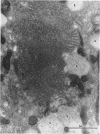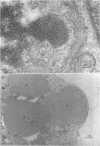Abstract
Two rubella virus strains isolated in this laboratory were investigated in terms of their growth in LLC-MK2 cell cultures and their effect on cell morphology. Rubella virus grew readily in LLC-MK2 cells, but cytopathic effects of the virus were not observed in infected cultures. Such infected cultures can be subcultured indefinitely and continue to shed virus. Examination of rubella-infected cell cultures by electron microscopy showed the presence of annulate lamellae in the cytoplasm of 15% of the cells. No changes were evident in the nuclei. These membranous inclusions varied in complexity from parallel arrays of annulate lamellae to large lamellar structures of complex morphology. An occasional cell contained a crystal lattice structure in association with the lamellae. Larger inclusions, consisting of disorganized arrays of “unit” membranes, were also found. Uninfected cells were devoid of annulate lamellae, crystals, and complex membranous inclusions. No viruslike particles were observed in any part of the cells from infected cultures. The significance of the structures observed has not been determined.
Full text
PDF









Images in this article
Selected References
These references are in PubMed. This may not be the complete list of references from this article.
- ADAMS W. R., PRINCE A. M. An electron microscopic study of incomplete virus formation; infection of Ehrlich ascites tumor cells with chick embryo-adapted Newcastle disease virus (NDV). J Exp Med. 1957 Nov 1;106(5):617–626. doi: 10.1084/jem.106.5.617. [DOI] [PMC free article] [PubMed] [Google Scholar]
- BROWN G. C., MAASSAB H. F., VERONELLI J. A., FRANCIS T. J., Jr RUBELLA ANTIBODIES IN HUMAN SERUM: DETECTION BY THE INDIRECT FLUORESCENT ANTIBODY TECHNIC. Science. 1964 Aug 28;145(3635):943–945. doi: 10.1126/science.145.3635.943. [DOI] [PubMed] [Google Scholar]
- CHAMBERS V. C., WEISER R. S. ANNULATE LAMELLAE IN SARCOMA I CELLS. J Cell Biol. 1964 Apr;21:133–139. doi: 10.1083/jcb.21.1.133. [DOI] [PMC free article] [PubMed] [Google Scholar]
- DALES S. REPLICATION OF ANIMAL VIRUSES AS STUDIED BY ELECTRON MICROSCOPY. Am J Med. 1965 May;38:699–715. doi: 10.1016/0002-9343(65)90191-9. [DOI] [PubMed] [Google Scholar]
- DALES S., SIMINOVITCH L. The development of vaccinia virus in Earle's L strain cells as examined by electron microscopy. J Biophys Biochem Cytol. 1961 Aug;10:475–503. doi: 10.1083/jcb.10.4.475. [DOI] [PMC free article] [PubMed] [Google Scholar]
- EMMELOT P., BENEDETTI E. L. Changes in the fine structure of rat liver cells brought about by dimethylnitrosamine. J Biophys Biochem Cytol. 1960 Apr;7:393–396. doi: 10.1083/jcb.7.2.393. [DOI] [PMC free article] [PubMed] [Google Scholar]
- EPSTEIN M. A. Some unusual features of fine structure observed in HeLa cells. J Biophys Biochem Cytol. 1961 Jun;10:153–162. doi: 10.1083/jcb.10.2.153. [DOI] [PMC free article] [PubMed] [Google Scholar]
- EPSTEIN M. A. The fine structure of the cells in mouse sarcoma 37 ascitic fluids. J Biophys Biochem Cytol. 1957 Jul 25;3(4):567–576. doi: 10.1083/jcb.3.4.567. [DOI] [PMC free article] [PubMed] [Google Scholar]
- GOFFE A. A DIPLOID HUMAN CELL STRAIN WITH CHRONIC INAPPARENT RUBELLA INFECTION. Arch Gesamte Virusforsch. 1965;16:469–469. doi: 10.1007/BF01253857. [DOI] [PubMed] [Google Scholar]
- GREGG M. B., MORGAN C. Reduplication of nuclear membranes in HeLa cells infected with adenovirus. J Biophys Biochem Cytol. 1959 Dec;6:539–540. doi: 10.1083/jcb.6.3.539. [DOI] [PMC free article] [PubMed] [Google Scholar]
- HARFORD C. G., HAMLIN A., PARKER E. Electron microscopy of early cytoplasmic changes due to influenza virus. J Exp Med. 1955 Jun 1;101(6):577–590. doi: 10.1084/jem.101.6.577. [DOI] [PMC free article] [PubMed] [Google Scholar]
- KARRER H. E. Electron microscopic study of the phagocytosis process in lung. J Biophys Biochem Cytol. 1960 Apr;7:357–366. doi: 10.1083/jcb.7.2.357. [DOI] [PMC free article] [PubMed] [Google Scholar]
- LUFT J. H. Improvements in epoxy resin embedding methods. J Biophys Biochem Cytol. 1961 Feb;9:409–414. doi: 10.1083/jcb.9.2.409. [DOI] [PMC free article] [PubMed] [Google Scholar]
- Lapis K. Electronmicroscopic examination of KB cell cultures infected with adenovirus type 12. Acta Microbiol Acad Sci Hung. 1965;12(3):241–259. [PubMed] [Google Scholar]
- MAGNUSSON P., NORRBY E. C. ON THE MORPHOLOGY OF RUBELLA VIRUS. Arch Gesamte Virusforsch. 1965;16:412–414. doi: 10.1007/BF01253847. [DOI] [PubMed] [Google Scholar]
- MORGAN C., ROSE H. M., HOLDEN M., JONES E. P. Electron microscopic observations on the development of herpes simplex virus. J Exp Med. 1959 Oct 1;110:643–656. doi: 10.1084/jem.110.4.643. [DOI] [PMC free article] [PubMed] [Google Scholar]
- MORGAN C., ROSE H. M., MOORE D. H. An evaluation of host cell changes accompanying viral multiplication as observed in the electron microscope. Ann N Y Acad Sci. 1957 Oct 21;68(2):302–323. doi: 10.1111/j.1749-6632.1957.tb56087.x. [DOI] [PubMed] [Google Scholar]
- PARKMAN P. D. BIOLOGICAL CHARACTERISTICS OF RUBELLA VIRUS. Arch Gesamte Virusforsch. 1965;16:401–411. doi: 10.1007/BF01253846. [DOI] [PubMed] [Google Scholar]
- PARKMAN P. D., BUESCHER E. L., ARTENSTEIN M. S. Recovery of rubella virus from army recruits. Proc Soc Exp Biol Med. 1962 Oct;111:225–230. doi: 10.3181/00379727-111-27750. [DOI] [PubMed] [Google Scholar]
- PHILLIPS C. A., BEHBEHANI A. M., JOHNSON L. W., MELNICK J. L. ISOLATION OF RUBELLA VIRUS: AN EPIDEMIC CHARACTERIZED BY RASH AND ARTHRITIS. JAMA. 1965 Feb 22;191:615–618. doi: 10.1001/jama.1965.03080080005001. [DOI] [PubMed] [Google Scholar]
- PLOTKIN S. A., BOUE A., BOUE J. G. THE IN VITRO GROWTH OF RUBELLA VIRUS IN HUMAN EMBRYO CELLS. Am J Epidemiol. 1965 Jan;81:71–85. doi: 10.1093/oxfordjournals.aje.a120499. [DOI] [PubMed] [Google Scholar]
- REBHUN L. I. Some electron microscope observations on membranous basophilic elements of invertebrate eggs. J Ultrastruct Res. 1961 Jun;5:208–225. doi: 10.1016/s0022-5320(61)90016-8. [DOI] [PubMed] [Google Scholar]
- RICHARDSON K. C., JARETT L., FINKE E. H. Embedding in epoxy resins for ultrathin sectioning in electron microscopy. Stain Technol. 1960 Nov;35:313–323. doi: 10.3109/10520296009114754. [DOI] [PubMed] [Google Scholar]
- ROSS M. H. Annulate lamellae in the adrenal cortex of the fetal rat. J Ultrastruct Res. 1962 Oct;7:373–382. doi: 10.1016/s0022-5320(62)90032-1. [DOI] [PubMed] [Google Scholar]
- Rawls W. E., Melnick J. L. Rubella virus carrier cultures derived from congenitally infected infants. J Exp Med. 1966 May 1;123(5):795–816. doi: 10.1084/jem.123.5.795. [DOI] [PMC free article] [PubMed] [Google Scholar]
- SWIFT H. The fine structure of annulate lamellae. J Biophys Biochem Cytol. 1956 Jul 25;2(4 Suppl):415–418. doi: 10.1083/jcb.2.4.415. [DOI] [PMC free article] [PubMed] [Google Scholar]
- VERONELLI J. A., MAASSAB H. F. CHARACTERIZATION OF GROWTH OF RUBELLA VIRUS IN LLC-MK 2 CELLS. Arch Gesamte Virusforsch. 1965;16:426–437. doi: 10.1007/BF01253851. [DOI] [PubMed] [Google Scholar]
- WELLER T. H., NEVA F. A. BIOLOGICAL CHARACTERISTICS OF RUBELLA VIRUS AS ASSAYED IN A HUMAN AMNION CULTURE SYSTEM. Arch Gesamte Virusforsch. 1965;16:393–400. doi: 10.1007/BF01253845. [DOI] [PubMed] [Google Scholar]
- Woods W. A., Johnson R. T., Hostetler D. D., Lepow M. L., Robbins F. C. Immunofluorescent studies on rubella-infected tissue cultures and human tissues. J Immunol. 1966 Feb;96(2):253–260. [PubMed] [Google Scholar]












